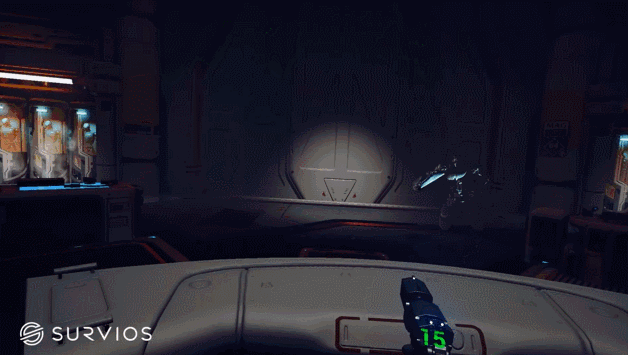[tc_aol_on code=”519496219″]
I want to play again. My arms are sore from shooting a virtual bow-and-arrow and slashing robots with a lightsaber. My heart is racing from dodging drone missiles and defending my teammate. And my mind is spinning from the possibilities. I want to play again. And I won’t be the only one.
The game is called Raw Data by virtual reality startup Survios. It’s perhaps the most advanced first person shooter in VR. Built by a team that’s been together for five years and a company for three, it’s the culmination of all Survios’ research into how people want to play.
Unlike most VR experiences today, it doesn’t feel like a demo. It’s something worth coming back to tonight, tomorrow, and next week, like great console and computer games. Survios isn’t so overwhelmed with the novelty of VR that it forgets what’s actually fun.

“Good game design includes progression and retention mechanics that” Survios’ co-founder and Chief Creative Officer James Iliff tells me. “It drives users to genuinely want to come back and continuing to level up, unlock classes, get new weapons, and open up new levels.”
So that’s how Survios built Raw Data.
A Game, Not A VR Demo
The story is that an evil corporation is secretly stealing human brains, putting them into cyborgs, and selling them for profit. Your goal is to infiltrate their headquarters, extract the Raw Data about their sinister scheme, and escape so you can expose them to the world. But while you download the evidence, you’re attacked by wave after wave of robots.

Thanks to the HTC Vive VR headset and its motion cameras you place in the corners of a room, you can actually run around a 15-foot by 15-foot space inside Raw Data. You’re able to duck and dodge, find cover behind computer terminals, and charge at your enemies.
You start with a pistol on your hip and a lightsaber on your back. By squeezing the grips on the Vive’s hand-held motion controllers, you can grab and dual wield them. Pull the trigger and the gun fires or the sword extends, and tap the extra button to slow things down to bullet time so pinpoint some head shots.
But what makes Raw Data feel addictive is that it’s constantly changing. After each wave get new weapons, like a pump-action shotgun where you actually line up your hands to aim down the iron sights, and a bow and arrow you nock, pull back, and release to fire. The enemies get smarter and stronger, advancing from lemming machines s to gun-toting soldierborgs to nimble ninjabots.

And you’re not alone in Raw Data. You can fight alongside a friend in their own HTC Vive playspace, and talk over the headset to coordinate strategy or call for help.
Iliff believes this all contributes to what he calls an “active VR experience” rather than one where you just sit and watch. By thrusting games into the action, he says “we can activate their primal instincts — where they don’t need to be trained to play, where you take advantage of people’s natural intuition.”
There’s no pop-up that teaches you to shoot the bow and arrow, you just feel like you need to figure it out to survive as if it was real life. Ready player 1?
From DIY To HTC Vive And Beyond
Survios wowed me a few years ago with its game Zombies On The Holodeck. The guys built it after working in the University of Southern California Mixed Reality Lab alongside Oculus co-founder Palmer Luckey. Though robots are cool, there’s something much scarier about the walking dead coming to eat your brains. Hopefully Survios will give the cyborgs saw-blade hands or something to make defeating them more urgent.

But what the startup learned from that Zombies game was how to build for any hardware. Way back in 2014 (VR moves fast), there weren’t any professionally-made systems available for doing full-motion virtual reality where you can walk around. Survios knew motion would make things much more fun, so it hacked together its own janky system. You had to strap on a massive backpack full of magnets for tracking location and a camera that hung above your head.
Fast-forward to today, and Survios has raised $4.2 million led by Shasta Ventures and grown its team to 35. Meanwhile, Oculus, Sony VR, and HTC have all built polished VR systems that are almost ready for sale. So rather than betting the company on one platform, Survios is using its hardware skills to bring Raw Data to all three of these headsets.
That’s no easy task when the headset launch dates keep getting pushed back. It’s hard to know how many people will buy them or how much they’ll be willing to pay for games. Survios expects to price Raw Data in the $10 to $25 range, and closely monitor reactions. Iliff believes that if VR games are about 10X shorter than traditional console games that cost $60, but is several times more immersive, around $20 will feel right.

Knowing that not everyone will be able to afford a premium wired VR headset, Survios has other plans to get people involved. It’s built the mechanics necessary so people will be able to spectate Raw Data games from their computer on Twitch, YouTube Gaming, and other streaming platforms. They’ll be able to watch from first-person or more cinematic angles.
“We trying to figure out ways to showing compelling VR experiences that don’t require a VR headset” Iliff explains. The theory is that once people watch someone else slice a robot’s head off with a lightsaber, they’ll be convinced its worth paying to hold the sword themselves. And they won’t want to put it down.






























Comment